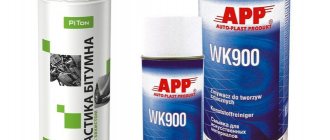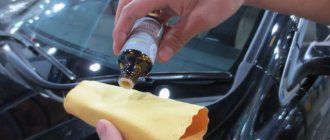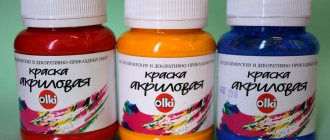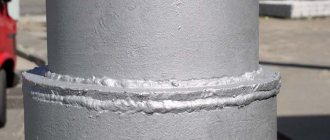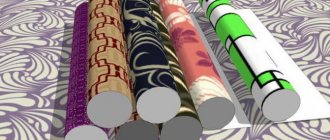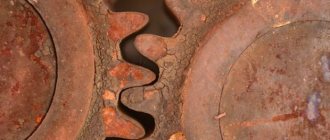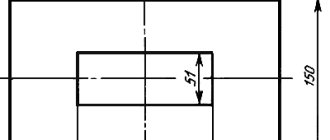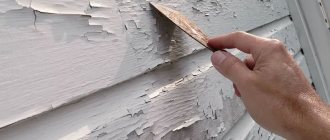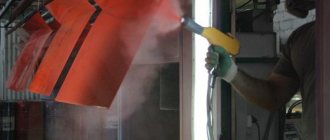The durability of paint and varnish coatings applied to a metal surface largely depends on the thoroughness of the preliminary preparation of the metal surface for painting.
The performance qualities of protective paint and varnish coatings significantly depend on the condition of the metal surface immediately before painting. The condition of surfaces requiring cleaning before painting can vary widely.
Different steel surfaces may have different initial states. Methods for assessing the surface condition of steel structures are established by international standards ISO 8501, 8502, 8503 .
Classification of metal surfaces
Metal surfaces to be cleaned are classified by degree of oxidation according to ISO 8501 and GOST 9.402 .
A – The surface of the metal is almost completely covered with mill scale adhered to the metal. There is almost no rust on the surface.
B – The metal surface has begun to rust, and mill scale begins to peel off from it.
C - A metal surface from which mill scale has almost completely disappeared as a result of corrosion, or from which mill scale can be easily removed. Small corrosion pitting is observed on the metal surface.
D – Metal surface from which mill scale has disappeared as a result of corrosion and on which pitting corrosion is observed over the entire surface.
Five degrees of cleaning during abrasive blasting
The SSPC organization (Scientists of Protective Coatings, USA) has established five levels of cleaning for abrasive blasting, ranging from complete removal of all contaminants to removal of only residual materials from the treated surface. These five degrees of purification include:
- cleaning to “white metal”,
- cleaning to “almost white metal”,
- commercial cleaning,
- industrial cleaning,
- surface cleaning.
These standards are subject to revision and amendment. But despite all this, they are used as basic principles. For a more detailed description of each, please refer to the Visual Standards for Cleaning Steel by Abrasive Blasting.
Cleaning to “white metal”
- This is cleaning visible without magnification. A cleaned surface to “white metal” is a surface from which all visible contaminants have been removed, namely: rust, mill scale, paint and foreign matter. Typically, this degree of cleaning is required when applying complex coatings (zinc-containing paints) to surfaces exposed to aggressive corrosive environments - chemical installations, offshore drilling rigs and bridges over waters with a high salt content.
Refinement to "almost white metal"
- This is cleaning visible without magnification. This is a surface free from all types of visible contaminants (rust, mill scale, paint and foreign matter). This type of cleaning is similar to cleaning to “white metal”. The only difference is that no more than 5% contamination is allowed on the surface to be cleaned. This type of cleaning is used when using high-performance coatings on steel surfaces exposed to harsh environments and intensive use.
Metal cleaning equipment
The Aox company offers its consumers automatic shot blasting chambers, habitable chambers, shot blasting equipment, shot blasting chambers and boxes, which ensure the cleaning of metal surfaces to the required condition. The work is carried out in accordance with GOSTs and international standards.
Commercial cleaning
- This is cleaning visible without magnification. The surface is cleaned of visible oil products, lubricants, dust, scale, dirt, secondary scale, corrosion products and foreign substances. With this cleaning, no more than 33% of contaminated areas, streaks, surface discoloration from rust stains, secondary scale and old coatings may remain on the surface. For most applications standard coatings are used.
Industrial cleaning
- This is cleaning visible without magnification. The surface is freed from all visible oil products, lubricants, dust and dirt. However, up to 10% of tightly adhered mill scale, rust and coating residue is acceptable if evenly distributed. The remainder of the surface may contain traces of dirt, streaking and discoloration caused by stains of rust, mill scale or old coating.
Surface cleaning
- visible without magnification. The surface treated in this way may contain tightly adhered residues of mill scale, rust or old coating. There is no need to expose metal stains if the substrate consists of an intact coating. This method is suitable for surfaces not exposed to harsh environmental conditions or where the coating is not expected to last long.
Where commercial or surface cleaning is required, care must be taken to ensure that the new coating is compatible with the old. Incompatible coatings may cause scaling or flaking.
SSPC offers a series of photographs that illustrate the four existing conditions of steel surfaces and the degree of cleaning of each. Existing conditions include:
- secondary scale,
- secondary scale and rust,
- complete corrosion
- and pitting corrosion.
The National Association of Corrosion Engineers (NACE) offers a set of sealed metal coupons that serve as reference grades. The Swedish Standards Institute's (SIS) printed publication of visual comparators is widely used in Europe.
Metal surface preparation
Metal surface preparation is one of the main conditions for successful anti-corrosion protection. There are many different conditions of metal surfaces that require cleaning before painting. First of all, this concerns the repair of previously painted surfaces.
The age of the object and its location, the quality of the original surface, the number of defects, the type of previous and future aggressive conditions, the properties of old coatings - all these factors influence the upcoming preparation of the metal surface. When choosing a surface preparation method, the required degree of cleaning and surface roughness should be taken into account.
To achieve the best result, the degree of surface preparation should be selected in accordance with the purpose of protection and the type of paintwork.
The most effective method of mechanical preparation of metal surfaces is abrasive blast cleaning. However, abrasive blasting is the most expensive method of surface preparation.
Abrasive blast cleaning is characterized by the following properties:
- the ability to achieve high productivity;
- different degrees of preparation and surface profiles can be achieved;
- the method is applicable to most types and shapes of surfaces;
- partial removal of individual sections of damaged coating is possible;
- abrasive blasting equipment can be either stationary or mobile.
How to paint metal?
Suitable products are the key to success, so when working with metal bases, this factor plays the most important role.
Universal materials
Painting can be carried out by the following common types of products:
- Epoxy. For the manufacture of such compositions, silicone resins are used, which are supplemented with a hardener. Due to their high toxicity, they are used only for outdoor work. They differ in the complexity of application.
Epoxy paint for metal is a strong and durable coating that provides excellent protection against corrosion. - Oily. A traditional option based on organic matter. Before treatment with this composition, the metal is pre-coated with primer. Due to the toxicity and pungent odor, parts can only be painted with good ventilation.
- Alkyd. They are in constant demand in cases where metal products need to be processed. Suitable for indoor and outdoor events. If the base is well prepared and has no problems, then the composition can be applied without prior priming.
- Acrylic. A modern polymer-based variety. Non-toxicity and ease of application make the material popular. The composition is suitable for painting metal surfaces subject to careful preparation.
- Rubber. Used for outdoor use, excellent for roofs or areas exposed to precipitation.
Rubber paint for metal is often used to finish galvanized roofing.
These solutions are considered classic and are used everywhere. The powder painting method stands out separately. It is complicated in that it requires the use of special equipment and tools.
On a note! When choosing the appropriate option, consumption, toxicity level, required degree of preparation, durability, special properties and cost are also assessed.
Specialized options
To ensure reliability and durability, in some cases special materials are required:
- Compositions used in the presence of rust. They are an epoxy variety with special additives. They create a reliable film, preventing further destruction. They are applied without pre-treatment of the base directly to rusty areas.
Profilux paint combines the properties of a primer, anti-corrosion paint and metal enamel - To prevent corrosion. Such materials provide the surface with additional protection from moisture and oxygen, that is, they do not allow parts to rust.
- Hammer compounds. They form an interesting decorative coating, reminiscent of traces of multiple hammer blows. They have good stability. Various base options are used for production: epoxy, acrylic, alkyd.
- Primer-enamel. A universal type of product that combines primer, corrosion protection and paint.
- Forging mixtures. Their production involves polymer compounds, which gives the coatings excellent wear resistance. Demonstrate good adhesion.
Forging paint Certa Plast - Nitro paint. Sold in cans. It is highly toxic.
There are other types of coloring mixtures - varnish and enamel, which are used in the processing of stoves and other similar products. They belong to heat-resistant materials.
Types of surface preparation
Metal surface preparation can be primary or secondary.
1. Primary (general) surface preparation is the preparation of the entire surface until the steel is exposed;
2. Secondary (local) surface preparation is the preparation of the surface leaving firmly adhered parts of organic and metal coatings.
Primary preparation is carried out to remove mill scale, rust, various contaminants and remnants of old coatings from the metal surface before applying the primer layer. After initial preparation, the entire surface is bare steel.
Scale is a very unreliable substrate, since it has a different expansion coefficient than steel, and therefore, when temperatures change, the brittle layer of scale can peel off (which leads to destruction of the coating).
Secondary preparation is carried out for the purpose of local removal of rust and foreign materials from the surface of the metal coated with a primer or impregnation, before applying an anti-corrosion protective composition.
The choice of processing method for metal painting is influenced by the material of the structure being cleaned, the thickness of the material, dimensions, conditions of the cleaning work, as well as the nature of the foreign inclusions being removed.
After local preparation of the metal surface, the remaining parts of the old coatings must be free of contaminants. If necessary, they should be roughened to ensure satisfactory adhesion.
2.4. Requirements for industrial waste disposal
2.4.1. Spent solutions are neutralized, rendered harmless or diluted before being discharged into the sewer system.
Sludge containing toxic substances is neutralized. The completeness of neutralization, neutralization or dilution is controlled by analysis.
2.4.2. The concentration of harmful substances in the air emitted into the atmosphere by local suction systems and in wastewater discharged into reservoirs from surface preparation installations must not exceed the maximum permissible concentrations approved by the USSR Ministry of Health.
